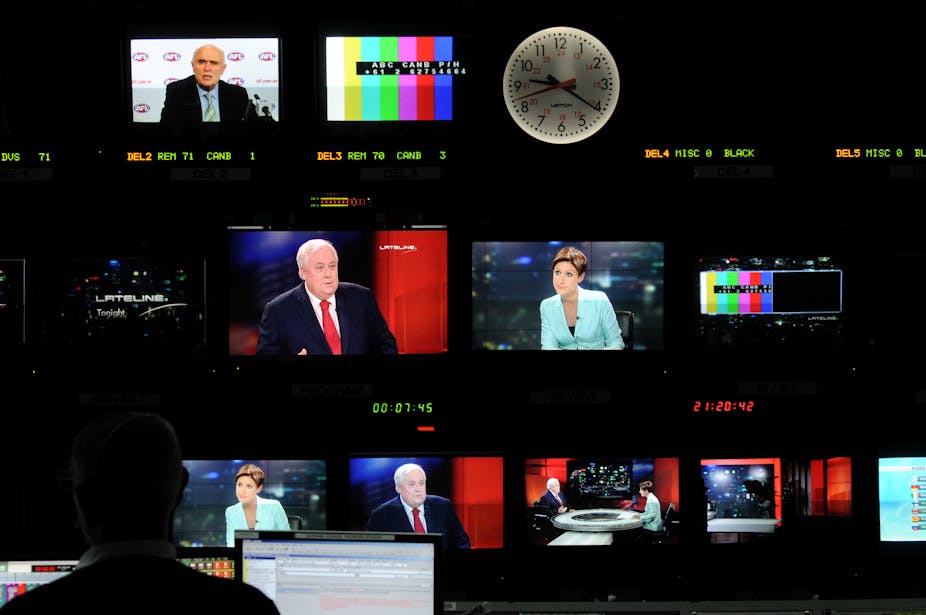The Abbott government is preparing to cut funding to the ABC. The end of the Australia Network in its present form is one saving already flagged by communications minister Malcolm Turnbull. And while the popularity of the ABC protects it from the threat of imminent destruction, the vultures are circling.
The Conversation UK recently asked what Britain would be like without the BBC, as it too struggles with looming cuts. But what would Australian culture be like if the ABC didn’t exist?
The most obvious absence would be impartial news and current affairs journalism of a certain quality and tone. All commercial media organisations produce news and current affairs, and often very well, but to very different criteria than those laid down by the ABC’s Charter.
Privately owned media are subject to commercial imperatives that are not present for the ABC. Like the ABC, commercial organisations provide and are committed to public interest journalism, but it is not their sole purpose and sometimes commercial imperatives come into conflict with it.
Channel 9’s A Current Affair, for example, sounds like a program dedicated to public interest reporting. However, on a day when the news agenda was dominated by civil war fears in the Ukraine and the death of asylum seeker Reza Barati on Manus Island, ACA’s lead story was “Australia’s identical twins,” a warm tale of two girls and their boyfriend problems.
Without the influence of the ABC, this is very likely all that mainstream, free-to-air Australian TV network viewers would get in the way of “current affairs”: a light, frothy, occasionally sensationalised and prurient mix of human interest, lifestyle and advertorial content.
This is not to criticise all human interest journalism, as it has an important and legitimate place in the recreation and entertainment schedules of millions of Australians. But what if that was all there was?

Public service media makes cheap and nasty news and current affairs look exactly like that by providing a benchmark for others to emulate. It doesn’t preclude the lighter touch of the commercial providers, but sets a context within which all serious journalism must be seen to be of comparable quality in terms of resource allocation and production standards.
We see this very clearly with Sky News in Australia, part-owned by Rupert Murdoch. Sky’s 24-hour news service is excellent on many criteria. But would Sky News Australia be so watchable in the absence of the ABC?
In the UK, Sky News is also a worthy provider of 24-hour news, highly respected and multi-award winning since its launch in 1989. News Corp’s UK tabloid newspapers, however, are vicious, morally bankrupt packages of sleaze and sensation. Rebekah Brooks and other former News employees are currently in a London courtroom, defending themselves against charges which – if proven – could well see them doing serious prison time.
A comparable public service competitor in the British newspaper market may have may have had a positive influence, in the same way the BBC obliged Sky News from the start to produce 24-hour news content of a quality competitive with the dominant publicly funded player.

All of this is not to say that BBC and ABC editors do not make mistakes, or that commercial journalism on TV or radio can’t be both innovative and excellent, or that the ABC isn’t sometimes lacking in the “oomph” factor when it comes to breaking news. Impartiality can be hard to make interesting because of the requirement to treat all sides in a debate fairly.
But we’d miss the ABC if it were gone and replaced by an endless procession of controversialists, shock jocks, ranters and class warriors. Think the Daily Telegraph or Alan Jones in high definition, big screen, surround sound, forever.
Our research highlights the growing importance of the ABC in Australian political culture. During 2013, we mapped the Australian public sphere, including established and familiar formats such as broadsheet news, current affairs and magazine television, “expert” or “insider” panel and debate programs, and public talkback radio, along with new and experimental human interest and infotainment genres, satire and public participation formats.
While the map provides a contemporary snapshot of Australia’s political public sphere, a historical comparison highlights key changes over the last 20 years.

As the table shows, between 1996-2013 Australia’s free-to-air commercial broadcasters devoted less time to political coverage while in the same period the ABC’s political coverage dramatically increased, thanks largely to the introduction of ABC News 24.
Digital platforms have further strengthened the ABC’s national coverage and allowed the introduction of experimental genres, styles and formats of political discourse. The ABC Charter requires the ABC to encourage innovation and to guarantee universal availability. The ABC also has to provide for minority and special interest groups, and offer educational and cultural programming that the commercial sector would be unlikely to supply on its own.
Examples of this programming include At the Movies, Catalyst (science), Message Stick (indigenous), Australian Story, Rage (music video), Landline (rural), Foreign Correspondent, Media Watch, Gardening Australia and Compass (religion and ethics).
These programs often rate well for the ABC, as OzTAM ratings figures for the week February 16-22, 2014 (Consolidated Metropolitan Total TV Share of All Viewing 5 City Share), show.

The challenge for the ABC in these times of political tension is to promote and defend the corporation’s achievements to counter some of the myths which circulate in the commercial media, and to remind taxpayers of the good value it represents.
The BBC receives the equivalent of about A$8 billion in revenue from various sources each year (mainly the licence fee). With this, it services more than 65 million viewers, listeners and online users.
The ABC makes do with an annual budget of A$1.2 billion to serve a population of 22 million. That’s about 45% of what the BBC gets, per head of population. Given the quality of the ABC’s output overall, that’s a good deal for the Australian taxpayer. Don’t let any private media proprietor tell you otherwise.

